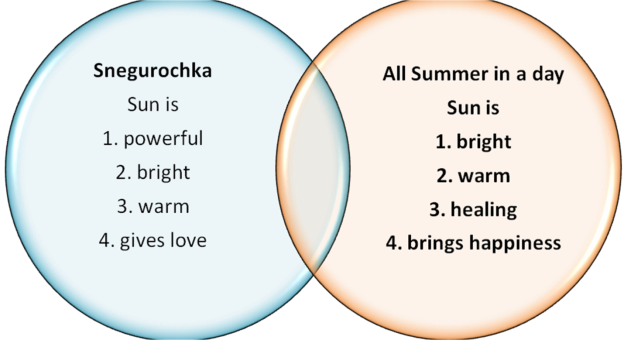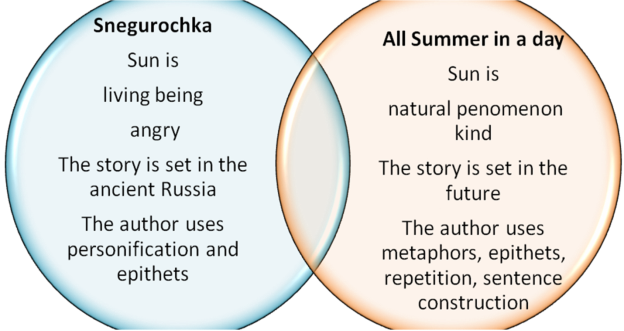This study aimed to explore the image and role of the Sun in the Ray Bradbury story «All Summer in a Day» and «Snegurochka» by Nikolay Ostrovsky. It analyzes how the authors describe the influence of the sun on people: their physical and mental health. Besides, the researcher examined the literary devices utilized by the authors to show the reader the significance of the sun for people. Nevertheless, this article includes a comparative analysis of the stories for differences and similarities. Findings revealed that both authors describe the Sun as a powerful and positive symbol for people. However, it was revealed that Ostrovsky described the sun as the god and personified it, whereas Bradbury presented the Sun as a part of nature.
Keywords: symbol, the Sun, perception, natural phenomenon.
Introduction
The Purpose of the Study
To compare and analyze two authors’ perceptions of the same symbol as the Sun in two different literature resources.
Objectives:
— to analyze the literature resources;
— to identify what literary devices are used by the authors to describe the Sun;
— to examine the importance of the Sun for people according to the stories;
— to determine differences and similarities between the image of the Sun in the two texts.
Research Question
How is the symbol of the Sun illustrated in the stories by Ray Bradbery, «All summer in one day» and «Snegurochka» by Alexander Ostrovsky?
Significance of the study
Nowadays, the connection between humans and nature has become a crucial issue. The massive expansion of the cities forces people to move to the urban areas, and consequently, they lose connection with nature. In my opinion, it is essential to study what relationship people have with nature and the Sun in particular since our generation should realize the significance of these relationships and maintain them for the future. Literature is one of the essential resources to develop this awareness for people of different ages. Therefore, I have decided to conduct this research.
It is widely recognized in world literature that people gave the powers of nature phenomena specific features similar to humans or gods. In Russian literature, the image of the Sun is closely connected with myths and fairy tales. Demchenko researched the Sun image in world literature and revealed that the Yarilo, as it was commonly named in Russian literature, was considered the symbol of beauty [3]. It is kind and warm, and people and animals love the Sun since it provides life yet, in some cases, death. Furthermore, in poetry, the Sun is described as a symbol of change. For example, when the Sun rises, it is the start of something new and unusual. Also, this has the diminutive name Solnyshko. In addition to this, the image of the Sun encompasses all poetry's colours and symbols, as well as images that convey mythological understanding, the sensation of something powerful and beautiful, the acceptance of emotions and feelings, and philosophical explanations of reality and fiction, as well as the depth of the poetic world.
The poem ‘Korkan Shundy’ is one instance where the idea of the mighty luminary as a natural element defining the universe is present. A rich arsenal of visual and expressive means is used in the text to create an exceptionally picturesque picture that is very dynamic and mobile, thanks to the use of many verbal image-personifications that depict the actions of the Sun as sparkling and iridescent [1].
According to Zhylyakov, the ‘chronology’ of nature ruled by the Sun: spring, summer, autumn, and winter are understood as inevitable movements and developments based on the idea of the universal unity of nature and man [4].
In ‘Snegurochka’, the author presents the strong attachment of people’s lives in ancient Russia to natural phenomena. Conversely, Bradbury demonstrates a future time when people live on Venus without the Sun. Life without the Sun negatively influences their mental and physical health. Thus, people need to have a good relationship with the sun and nature. Recent research revealed that those people who have a connection with nature live happier life and report feeling their lives are valuable. For these reasons, I have chosen to study this problem to illustrate how essential the sun is for people. It was also interesting to research how people of different cultures, Russian and American, perceive the Sun through the literature.
Methodology
This research employed comparative analysis of the texts to distinguish the author’s opinions and ideas regarding the symbol of the Sun. Moreover, the researcher analyzed literary devices that were utilized by the authors. In order to understand what perception of the sun people have
The stories were chosen as the resources where the Sun is one of the main characters and plays a significant role. Besides, it was emphasized that Alexandr Ostrovsky in ‘Snegurochka’ tells about people’s lives in the past and their relationship with natural phenomena. Bradbury describes how people will live in the future on other planets.
Data Collection Methods and Instruments
In order to understand how the writers perceive and present the symbol of the Sun in their stories I have decided to analyze the texts for the context and the figurative language they used. It is important to enquire about the literature devices as the authors transmit their opinions towards events and characters through these techniques.
Furthermore, I have conducted a survey among 11 grade students about their perception of the Sun. The study was based on the ethical standards to treat the participants with respect and not to harm them. The survey was conducted anonymously so the participants were not required to enter such personal information as name and email. They only stated their gender and age range. Moreover, participation in the research was voluntary, as a link to the survey was sent to more than 30 people, and the respondents could not see answered questions. For the survey I have designed the following questions:
- What does Sun mean to you?
- Do you think people can live without the Sun?
- Have you read the stories about the Sun?
According to the results of the survey, respondents understand the Sun as a warmth — 31 %, light 28 %, bright star — 23 % and source of energy 18 %.

Fig. 1. Question 1
What is more, almost all participants think that people would not be able to live without the Sun. Some participants explained this by the following:
‘ The Earth will be covered by ice’
‘The amount of vitamin D will be on the low level, and people will experience health issues.

Fig. 2. Question 2
Besides, regarding the last question about literature that students read about the sun, more than 70 % of the participants answered that they had read ‘Little Prince ’ by A.de Saint-Exupery. Another 28 % of the respondents replied that they haven’t read any story about the sun or where this is one of the characters.

Fig. 3. Question 3
Data analysis
Since humanity is inextricably linked with nature and natural phenomena, both in the ecosystem and in the story of Ray Bradbury, ‘All summer in one day’, the author reveals the great significance of such a symbol as the Sun, where he shows the close connection between man and nature. On Venus, the Sun comes out once every seven years, and the rest of the time, people have to live in the dark because it rains all the time, and, accordingly, the days are dull and grey. The author uses repetition as ‘thousands upon thousands’ to create a heavy and depressing feeling.
Therefore, in my opinion, people living on Venus have broken the whole chain of communication with nature, where there is no such link as the Sun. Even a character like Margot, who saw the Sun on planet Earth, was spiritually and physically depressed on Venus because of its absence. The energy of the Sun is infinite and healing, which can be seen in the part of the story when the children saw the Sun, where their emotions and physical condition differed from the ordinary state of mind, which was during a long rainy period. They felt this on their skin, and the sun's bright light gave them strength and vital energy, which they did not have before.
In Bradbury’s text, the sun symbolizes happiness, energy, vitality and freedom. The theme of the power of nature is explored in the text. Thus, the author highlights the importance of nature, and in particular, of the Sun. For the first time, we see the children happy and full of energy, which implies that the Sun has a positive influence on our well-being.
The author explicitly tells us that Margo is 'frail' and then describes her as though the rain had washed the colour out of her and uses the metaphor as an 'old photograph' to underline how the sun impacts children’s physical health. It suggests that she looks pale, grey, monotone, almost sickly or someone who is not very lively. She also does not speak often, but when she does, 'her voice is like a 'ghost', implying that she speaks very softly because she does not have strength. Based on this, Margot appears to be thin, weak and dull. The story contains evidence of the importance of travel back to Earth for Margot. It seems that Margot cannot cope with living on Venus. Firstly, the harsh weather conditions depress her to a point where she does not even want to shower. Secondly, Margot is isolated and bullied by the children for being 'different'. She also longs for the Sun and to be back on Earth but is deprived of this. All these factors have taken a toll on her mental well-being. The children 'hate' Margot because she remembers the Sun, and there is a possibility that she may go back to Earth, which means a brighter, normal future while they remain on Venus. Therefore, they are envious of her and treat her poorly. And the reason for all is that people on Venus do not have access to a sun-like natural phenomenon, which may alter the planet's climate and affect people's mental health, interpersonal connections, and way of life in general.
Bradbury creates a sense of being trapped when the children are described as bunched together and looking out the window. It gives the reader the impression that they are not free to run outside. They cannot remember the Sun and dream about the sun. Life on Venus also seems to be depressing. The rain is described as a 'concussion of storms' that are so heavy they are like tidal waves. Also, the repetition of 'thousands' and 'crushed' create a very heavy and depressing feeling.
To convey the idea about the Sun and about living without the Sun, Bradbury used literary techniques: repetition, similes, metaphors, and sentence construction.
Bradbury uses metaphors like ‘gold or a yellow crayon’, ‘a coin huge enough’, ‘the Sun is a flower’, and the simile ‘like a lemon’ to describe the Sun's brilliance, size, and beauty. The quality of warmth and comfort is described as well: a warmness, like a blushing in the face, body, arms, and legs. Bradbury uses the metaphor ‘It was the colour of burning bronze’ to show the same signs of colour and brilliance that occur when a bright light shines on a material like bronze because this metal starts to dazzle brightly yellow like the yellow radiance of the Sun. To further help the reader understand how the children felt, the author uses the simile ‘like a warm iron’ to describe how they felt as the Sun warmed their cheeks and shone brightly in the sky. The children laugh, run, play, and are full of energy. They behave like normal children.
According to the definition of the Sun in Russian literature, Yarilo is the spring God of the Sun, the God of spring wind and heat, and the God of conception and awakening of nature. It signified fruitful love. Although Yarilo is silent in the story, he is one of the main characters. Other characters describe it. For example, Father Frost says: 'Angry Yarilo, scorching god…' the author used this epithet to show that Yarilo is a powerful natural phenomenon. Also, The Spring in her words:
'Sun is jealous and looks at us angrily,
And frowns at everyone…..'
confirms the significant role of the Sun for people and nature.
Despite the death of Snegurochka and Mizgir, Tsar Berendey says:
'Snegurochka sad demise
And the terrible death of Mizgir
They cannot disturb us; the Sun knows,
Whom to punish and pardon. Accomplished
A truthful trial! '
In these words, the author gives a characterization of Yarilo as a strong and fair creature.
In contrast, ordinary people characterize Yarilo as 'Yario bright' to underline their respect and love for the Sun. It also can be seen in the following words of chor:
‘Light and Power,
God Yarilo.
The Red Sun is ours!
There is no you in the world more beautiful!’
People treat the Sun as a living being because it brings warmth, love and good yield. Without the Sun, spring became longer and colder. People forgot how to love and became indifferent to each other. The Tsar Berendei says:
‘In the hearts of people, I noticed I would cool down
Considerable; the ardor of love
I have not seen Berendeevs for a long time.
The service of beauty has disappeared in them;
I do not see the eyes of young people,
Moistened with a charming passion.’
The author also uses personification, ‘The sun-splashed ruddy rays on the treetops’, to indicate how beautiful it can be.
Limitations of the Study
There are only two stories that were taken for analysis in the research. These might be the possible limitations because writers have different perspectives of illustrating the Sun in their stories. Hence, covering more sources would give an opportunity to have other results of the research. But this research shows only the comparative analysis of two different stories American and Russian.
Findings
This section discusses the differences and similarities found during the analysis of the two sources. It is found that both authors attribute significant importance to the Sun in people's lives. In Bradbury's story, the Sun symbolizes light, warmth, and health. Similarly, the Sun is bright and warm and gives warmth and harvest, according to Ostrovsky's description in ‘Snegurochka’.
Since the events in ‘Snegurochka’ occur in ancient times, people identify the Sun with God and a living being, even afraid of his anger. Moreover, the sun appears powerful, strong, capable of loving, being angry, and giving love and light as a living being. While Ray Bradbury's story describes people’s lives in the future, the Sun is considered a natural phenomenon.
What is more, Bradbury suggests that children who see the Sun once every seven years have mental and physical health problems. In the same way, in the story by Ostrovsky, people lose their emotions and become apathetic, to one another, as the descriptions of human emotions in 'All summer in one day’. In addition, the people and Tsar Berendey agree that Snegurochka and Mezgir's deaths in the final part of the poem by Ostrovsky are fair. Hence their well-being depends on the Sun. At the end of the novel by Ray Bradbury, the Sun purifies the souls of the kids, who then feel empathy and understanding for Margot and let her out of the closet. Children that spend two hours in the Sun become happy.

Fig. 4. Similarities

Fig. 5. Differences
Conclusion
The aim of the present research was to analyse two literature resources: 'All summer in one day' and 'Snegurochka' to identify how the image of the Sun is illustrated in these resources. The study has shown that both authors Ray Bradbury and Alexandr Ostrovsky describe the sun as something powerful, bright, and warm that gives love and fruitfulness. Ostrovsky is different from Bradbury in the perspective of the sun. He represents the sun from Russian mythology as Yarilo, the God of spring and uses personification more to characterize the Sun. In contrast, Bradbery uses metaphor and simile to describe the sun as a natural phenomenon and its effect on people.
References:
- Arekeyeva S. T. and Kondratieva N. V., (2021). THE IMAGE OF THE ‘SUN’ IN THE POETRY OF KUZEBAI GERD. Editorial Board, 8.
- Bradbury, R., (1954) All Summer in a Day
- Demchenko L. N., (2019). The image of the sun in the works of world literature. European journal of literature and linguistics, (3), 22–25.
- Zhylyakov A. S., (2008). Genre originality of the literary fairy tale of the turn of the XIX-XX centuries (‘Posolon’ AM Remizova -’ Pack from the Magic Hills’ R. Kipling).
- Ostrovsky, A. (1873) Snegurochka









